| © 2022 Black Swan Telecom Journal | • | protecting and growing a robust communications business | • a service of | |
| Email a colleague |
December 2020
PRISM Report on IPRN Trends 2020: An Analysis of the Destinations Fraudsters Use in IRSF & Wangiri Attacks

If conventional wisdom was always correct, there would be no need for scientific investigation.
Back in the 17th century, prisms that create a rainbow of colors were well known. However, the conventional belief back then was that a prism somehow dyed the white light that passed through it to create a rainbow.
Sir Isaac Newton in England was curious about this problem so he went to work on it using a lamp and prism. After many experiments, he eventually passed the green light from one prism through a pinpoint hole in a barrier which aimed the green light at a second prism. And the output color from that second prism was not a rainbow as expected, but only the color green. In this way, Newton proved that the spectrum of colors is a characteristic of white light itself.
When Colin Yates headed up the Fraud Department at the Vodafone Group in the 2010s, he and his team conducted their own scientific investigation in search of a better way of detecting Wangiri and International Revenue Share Fraud (IRSF). The issue? Vodafone had no efficient method of gaining an advantage on fraudsters due to two barriers:
- Blacklists of fraud numbers were not effective — You could save
the phone numbers that the fraudsters used in their IRSF attacks in a blacklist,
but unfortunately — even if telecoms shared those blacklisted numbers
with each other — the fraudster could simply commit IRSF using new numbers.
- Analytic number-crunching was only partially effective in detecting IRSF
attacks. And that meant you had to spend a small fortune hiring lots
of fraud analysts to track down and decide if a potential IRSF attack was real
or not.
But through a deeper observation of how IRSF fraud is conducted, Yates and his team came up with an insight that would give Vodafone a leg up on detection. That idea begins by understanding there are two parties in any IRSF attack:
- The Fraudster (also called the Call Generator) is the party who pumps
a massive volume of calls — in a relatively short period of time —
through a hacked device (PBX or cellphone) to commit the fraud.
- The IPRN Provider is the insider party who has control over the destination
phone numbers the Fraudster uses to pump its IRSF traffic. In all
cases, the IPRN provider inserts himself into the billing stream or gets a payoff
from an insider. When payment is received from the transit operator, the
IPRN Provider then pays the Fraudster the agreed-upon fee and pockets the
rest himself.
Now the way the Fraudster and IPRN provider coordinate is what led to the breakthrough. To remain anonymous, the IPRN provider is forced to advertise his list of IPRNs on a website. And there are more than 120 such public websites today where the Fraudster chooses its IPRN numbers for an upcoming IRSF traffic pumping campaign.
However, a few minutes before each IRSF attack, the Fraudster must test its numbers to confirm with the IPRN provider that the calls can go through. And it’s precisely this test call where Vodafone inserted its innovation.
By collecting all the IPRNs advertised across the world, Vodafone created a powerful “early warning” database. Then, every time a fraudster tested an IPRN, the Vodafone fraud team knew an IRSF attack was imminent so it could block the attack right from the start.
The system worked beautifully, and today the IPRN database has become integral to Vodafone’s method of blocking IRSF and Wangiri.
Then, when Colin Yates retired from Vodafone a few years later, he teamed up with FRS Labs in India to launch PRISM, an IPRN database that any operator could lease for about $7,000 a year with bi-weekly updates.
When PRISM was launched back in 2013/2014, the database had some 70,000 numbers and now — as of 20 November 2020 — the number has grown to over 6.2 million numbers. And 70+ operators around the world use it. Many of them claim the IPRN database successfully detects between 50 and 80% of traffic pumping attacks.
Well, Colin Yates has just completed his customary end-the-year Report on IPRN trends. And just before Colin could put on his swimming shorts to enjoy New Zealand’s summer holiday, I contacted him to share with us his latest IPRN findings.
| Colin, great to connect you again with Black Swan readers. What’s the methodology behind your IPRN Trends Report? And what are some of the trends you’ve discovered? |
Colin Yates: Dan, we are actively tracking the websites where IPRNs are advertised. And since we collect fresh data every two weeks to update PRISM, I like to analyze the data to see what trends we can find in terms of growth or decline in specific country destinations where telephone numbers reside.
We currently track 230 country destinations in PRISM and I’m going to present some charts that highlight the countries that have the highest number of IPRNs.
Yet aside from whatever Top 10 or Top 20 analysis I’m going to show, any IPRN number in any country destination — high risk or low risk — is a risky number and could lead to substantial IRSF or Wangiri fraud losses.
So let me discuss our major findings one by one.
1. Huge Growth in IPRNs being Advertised
The most alarming trend in the data is the year-over-year increase in number of IPRNs being advertised worldwide.
In April 2020 there were 3 million IPRNs advertising vs. only 1.1 million in April 2019. That’s an almost a 3X increase in IPRNs!
On a worldwide scale, the continent of Africa continues to be the region with the largest number of IPRNs. Actually our Report finds there’s been very little change in the overall distribution of numbers across the continents although Oceania, with an 84% increase, grew substantially less than other continents.
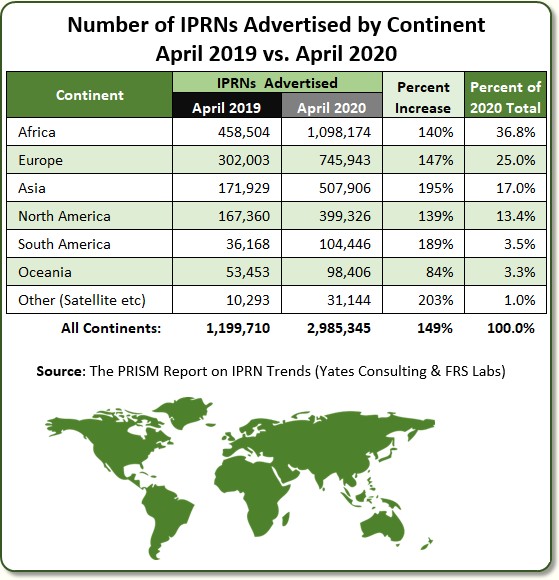
| What do you feel is the cause of this extraordinary increase in IPRNs being advertised? Do fraudsters need a larger set of numbers so they can keep their thresholds lower and avoid detection? |
Most IPRN Providers are competing for business, and I feel that some have a view that the more numbers they advertise, the more choice they offer to their potential users, which makes them more attractive as an IPRN Provider.
Also, if a carrier blocks a country code or a range within that country code, they can’t block every potential IRSF number without impacting legitimate revenues. IPRN Providers want to have sufficient number stock to provide sufficient choice to their potential users so they do not have to go to another site to find number ranges that have not been blocked when doing their call testing.
2. Changing Destinations for IPRNs by Country
In the first four years (2013-2016) of our PRISM journey, the top 10 high risk country destinations didn’t change much. These countries — Latvia, Cuba, Lithuania, Somalia, and more — accounted for 46% to 50% of all numbers in PRISM.
But around 2017, this profile began to change. The reason is CSPs got a lot better at monitoring and blocking calls to these high-risk destinations to avoid fraud losses. So fraudsters got active in changing their IPRN schemes.
In the last 4 year period, the percent of IPRNs in top 10 high risk destinations has dropped considerably: in our November 2020 report, these 10 destinations are now responsible for less than 15% of the 6.2 million numbers in PRISM.
In fact, the Top 10 list now includes four countries who have never been in the Top 10 before: the United Kingdom, Iraq, Afghanistan, and Sri Lanka. See the chart below.
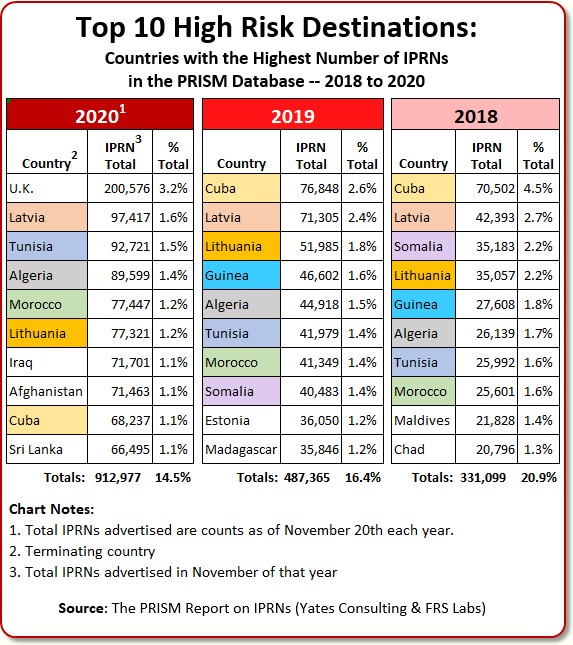
|
Colin, so what should an operator’s strategy be? In years past,
you could rely on a few countries to be risky and they were small countries.
But look at the new countries on the list today. You’ve got the United Kingdom on top. And other new ones in the Top 10 are Iraq, Afghanistan, and Sri Lanka. All these countries have good sized populations. Is the point you can no longer rely on rule-of-thumb blocking of certain countries? |
Correct, Dan. To use PRISM effectively, we recommend our users put some thought into how they are going to utilize these numbers. For example, in the 2020 high risk destinations above, the UK is way out in front with the highest quantity of IPRNs advertised. No carrier can take the risk of blocking the UK, and it will be a popular calling destination from every other country.
Other countries in that top 10, such as Iraq or Algeria, may only have a few legitimate calls a month from some smaller carriers, so they could take a different approach without having a negative impact on the business. Fraud Management generally requires support from all of the business and implementing a blocking or monitoring strategy based on PRISM numbers also requires this business support.
3. Most IPRNs Advertised Analysis
In the next chart we have a High to Low list of Destination Countries who have the highest total IPRNs advertised in November 2020. The numbers in the 2020 ranking column show the position each of those countries sits in the November 2020 risk profile, and the entry in column 4 is their ranking on 20 November 2019.
Of these 20 destinations, only 1 (Afghanistan) is in the “highest growth” category. It’s also interesting to note that the highest risk destination from 2019 (Latvia) only increased their numbers by 33% over this year. Cuba, Number 2 in 2019, decreased by 8%; Lithuania, at number 3 in 2019, fell 55%, all against an average increase across all destinations of 148%. Likewise, 9 of the top 20 destinations did not make this list 12 months ago, which seems to confirm our view that the global destination risk profile is changing.
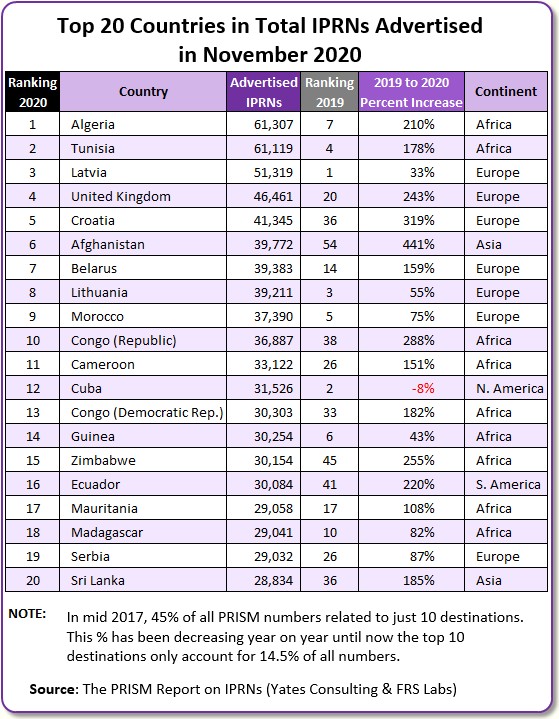
| For what reason are IPRN providers flattening the distribution curve of IPRNs across the globe? |
Well, we feel the IPRN Providers are changing their number stocks to try and avoid providing numbers in destinations that are being blocked. They know that through industry organizations such as the GSMA, CFCA, RAG, etc, IPRNs used in fraud attacks are being shared, and consequently blocked.
IPRN Providers know that it is pointless to keep advertising numbers or destinations that have been used previously, and are likely to now be blocked. As they identify their own numbers that have been blocked, they remove these from their lists and replace these with new numbers, and frequently new countries that may not be blocked.
4. Recently Added Numbers are Significant
Two years ago we found it prudent to increase our PRISM database updates to twice a month. During the year December 2019 to November 2020, we added 6.4 million new numbers to PRISM.
The new numbers for November 2020 are shown in the chart below.
Note that only 5 of these destinations were in this top 20 new number list during November 2019, and only 9 of these are in the top 20 highest risk list. New numbers are significant because — as a general rule — the new numbers added in current and previous months are the ones most likely to be used in any current IRSF attack.
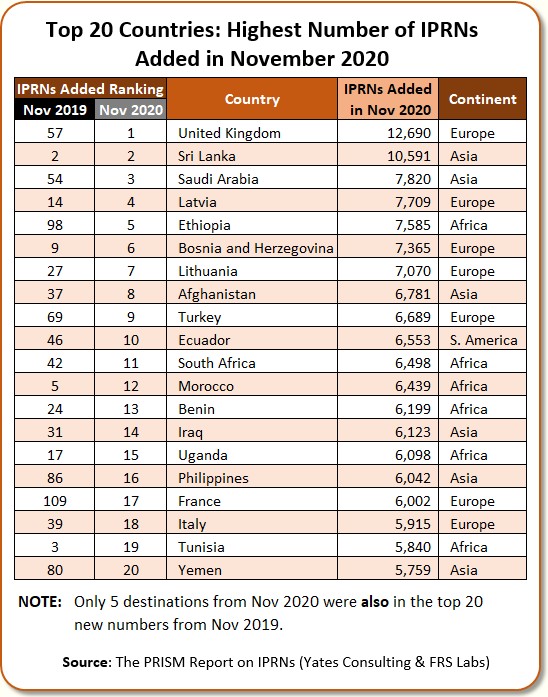
| Thanks for this update, Colin. It’s highly interesting. And it’s great to keep up with IPRN trends: it gives us some clues on the aggregate direction the criminals are moving. |
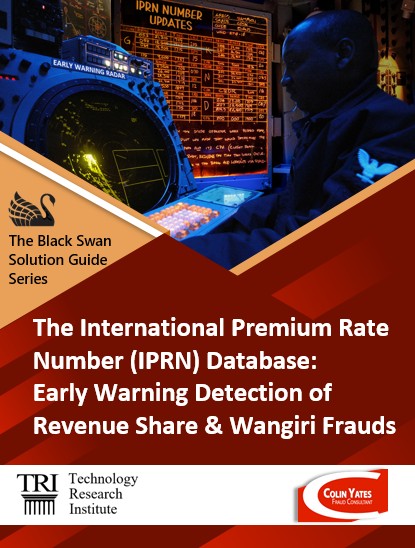
NOTE to Readers: In late 2019, Colin Yates and I got together to write a Black Swan Solution Guide that provides a deep dive analysis of IPRNs and Colin’s PRISM Database.
The value of PRISM is not so easy to grasp at first glance because it requires a knowledge of IRSF and Wangiri fraud — and the larger fraud control process. However the Guide lays it all out across 14 pages with Colin Yates’ commentary.
To download the free Guide, click the image at right.
Copyright 2020 Black Swan Telecom Journal
Black Swan Solution Guides & Papers
- Expanding the Scope of Revenue Assurance Beyond Switch-to-Bill’s Vision — Araxxe — How Araxxe’s end-to-end revenue assurance complements switch-to-bill RA through telescope RA (external and partner data) and microscope RA (high-definition analysis of complex services like bundling and digital services).
- Lanck Telecom FMS: Voice Fraud Management as a Network Service on Demand — Lanck Telecom — A Guide to a new and unique on-demand network service enabling fraud-risky international voice traffic to be monitored (and either alerted or blocked) as that traffic is routed through a wholesaler on its way to its final destinations.
- SHAKEN / STIR Calling Number Verification & Fraud Alerting — iconectiv — SHAKEN/STIR is the telecom industry’s first step toward reviving trust in business telephony — and has recently launched in the U.S. market. This Solution Guide features commentary from technology leaders at iconetiv, a firm heavily involved in the development of SHAKEN.
- Getting Accurate, Up-to-the-Minute Phone Number Porting History & Carrier-of-Record Data to Verify Identity & Mitigate Account Takeovers — iconectiv — Learn about a recently approved risk intelligence service to receive authoritative and real-time notices of numbers being ported and changes to the carrier-of-record for specific telephone numbers.
- The Value of an Authoritative Database of Global Telephone Numbers — iconectiv — Learn about an authoritative database of allocated numbers and special number ranges in every country of the world. The expert explains how this database adds value to any FMS or fraud analyst team.
- The IPRN Database and its Use in IRSF & Wangiri Fraud Control — Yates Fraud Consulting — The IPRN Database is a powerful new tool for helping control IRSF and Wangiri frauds. The pioneer of the category explains the value and use of the IPRN Database in this 14-page Black Swan Solution Guide.
- A Real-Time Cloud Service to Protect the Enterprise PBX from IRSF Fraud — Oculeus — Learn how a new cloud-based solution developed by Oculeus, any enterprise can protect its PBX from IRSF fraud for as little as $5 a month.
- How Regulators can Lead the Fight Against International Bypass Fraud — LATRO Services — As a regulator in a country infected by SIM box fraud, what can you do to improve the situation? A white paper explains the steps you can and should you take — at the national government level — to better protect your country’s tax revenue, quality of communications, and national infrastructure.
- Telecom Identity Fraud 2020: A 36-Expert Analysis Report from TRI — TRI — TRI releases a new research report on telecom identity fraud and security. Black Swan readers can download a free Executive Summary of the Report.
- The 2021 State of Communications-Related Fraud, Identity Theft & Consumer Protection in the USA — iconectiv — This 49-page free Report on communications-related fraud analyzes the FTC’s annual Sentinel consumer fraud statistics and provides a sweeping view of trends and problem areas. It also gives a cross-industry view of the practices and systems that enable fraud control, identity verification, and security in our “zero trust” digital world.
Recent Stories
- Epsilon’s Infiny NaaS Platform Brings Global Connection, Agility & Fast Provision for IoT, Clouds & Enterprises in Southeast Asia, China & Beyond — interview with Warren Aw , Epsilon
- PCCW Global: On Leveraging Global IoT Connectivity to Create Mission Critical Use Cases for Enterprises — interview with Craig Price , PCCW Global
- Subex Explains its IoT Security Research Methods: From Malware & Coding Analysis to Distribution & Bad Actor Tracking — interview with Kiran Zachariah , Subex
- Mobile Security Leverage: MNOs to Tool up with Distributed Security Services for Globally-Connected, Mission Critical IoT — interview with Jimmy Jones , Positive Technologies
- TEOCO Brings Bottom Line Savings & Efficiency to Inter-Carrier Billing and Accounting with Machine Learning & Contract Scanning — interview with Jacob Howell , TEOCO
- PRISM Report on IPRN Trends 2020: An Analysis of the Destinations Fraudsters Use in IRSF & Wangiri Attacks — interview with Colin Yates , Yates Consulting
- Telecom Identity Fraud 2020: A 36-Expert Analyst Report on Subscription Fraud, Identity, KYC and Security — by Dan Baker , TRI
- Tackling Telecoms Subscription Fraud in a Digital World — interview with Mel Prescott & Andy Procter , FICO
- How an Energized Antifraud System with SLAs & Revenue Share is Powering Business Growth at Wholesaler iBASIS — interview with Malick Aissi , iBASIS
- Mobileum Tackles Subscription Fraud and ID Spoofing with Machine Learning that is Explainable — interview with Carlos Martins , Mobileum


